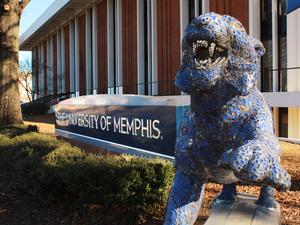
A few years ago, as University of Memphis officials geared up for a major research push, they took a close look at the institution’s funding landscape and asked, "What were its big sources of research funding, and where was there room for growth?"
Historically, U of M had scored ample amounts of funding from the National Science Foundation (NSF) and the National Institutes of Health (NIH). It had received relatively small amounts, however, from the U.S. Department of Defense (DoD), especially when compared to institutions of a similar size.
This tracked with statewide trends, as Tennessee had one of the lowest defense R&D allocations in the country. But increasing the amount of research money received from the DoD made sense for U of M.
The school wanted to build its research capacity, and the Department of Defense has a massive research budget — one significantly larger than either the NSF or the NIH. It also seemed like an ideal partner for the DoD. Already, U of M had done notable research in areas the DoD cared about. And Memphis was home to the William B. Morgan Large Cavitation Channel, which is run by the Naval Sea Systems Command.
So, U of M began to pursue more research funding from the DoD. It bolstered its relationship with the team overseeing the cavitation channel, and with established contacts it had at the Department of Defense. Faculty members reached out to colleagues they had at other universities with DoD support.
“We started building that capacity to support growing that as a research sector for us,” said Cody Behles, U of M’s director of research development and innovation.
The long process
Gaining funding for projects from the DoD, however, didn’t happen quickly. As Behles noted, “It's not as simple as just applying to a grant application.”
Typically, if a university wants a big project to be funded by the Department of Defense, the money for that project needs to be allocated in a budget passed at the federal level — which means it will often have to earn congressional support. Then the DoD does its due diligence on the matter, and it’s not until after this that a university can actually apply for the funding.
According to Behles, it takes about two years just to secure funding from the Department of Defense for a project.
Notable wins
But the slow process has been a successful one, and U of M is seeing results from the effort.
The first major victory came when U of M engineering professor Eddie Jacobs scored a multimillion-dollar research award for his project, "Multi-UAS Multi-Sensor Intelligence, Surveillance, and Reconnaissance," which grew the total amount of funding the university received.
In FY 2019, U of M earned $2.25 million in research funding from the DoD, and in FY 2022, that number more than doubled, to $4.91 million, according to the school's annual research report. And that could just be the beginning. As the office of U.S. Rep. Steve Cohen recently announced, a total of $22.65 million in the federal defense budget has been allocated for three research projects at U of M.
Building capacity for a bigger picture
The DoD focus is one piece of a larger puzzle at the university, which gained R1 status from the Carnegie Classifications of Institutions of Higher Education — a top research designation — in December 2021. Now, it’s looking to retain that status, and continue growing as a research hub.
But to do this, it will need to build out its research infrastructure and capacity.
“One of the challenges for Memphis — and really for the whole Delta region — is that there's a lack of applied and experimental research infrastructure,” Behles said. “And without major investments in research infrastructure, it's hard to build capacity.”
But U of M will need that capacity, he believes, to continue growing as a research institution — which is one of the reasons the effort to gain more research funding from the DoD is so important. It can be an effective way to build out infrastructure.
“It's one of those things where you have to incrementally build your capacity, and the DoD is a good place to do that,” Behles said. “Because they are able to invest in research capacity and research facility capacity, it's probably the most accessible funding for capacity development.”
And that capacity development, Behles believes, will play a role in a research push that could strengthen the entire city.
“When you think about innovation hubs nationally — Silicon Valley, Boston, even places like Atlanta — the foundation for why they are innovation hubs is research-active institutions,” he said. “You have a confluence of ideas in a space. And if we don't build that confluence of ideas, then we can't move our whole economy forward."







